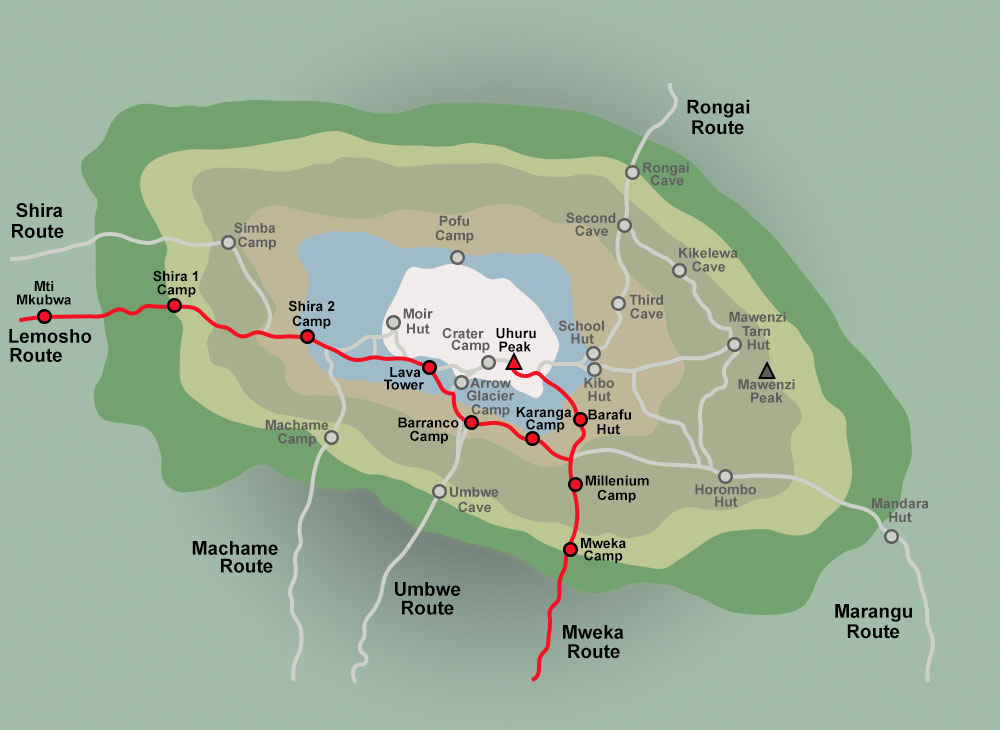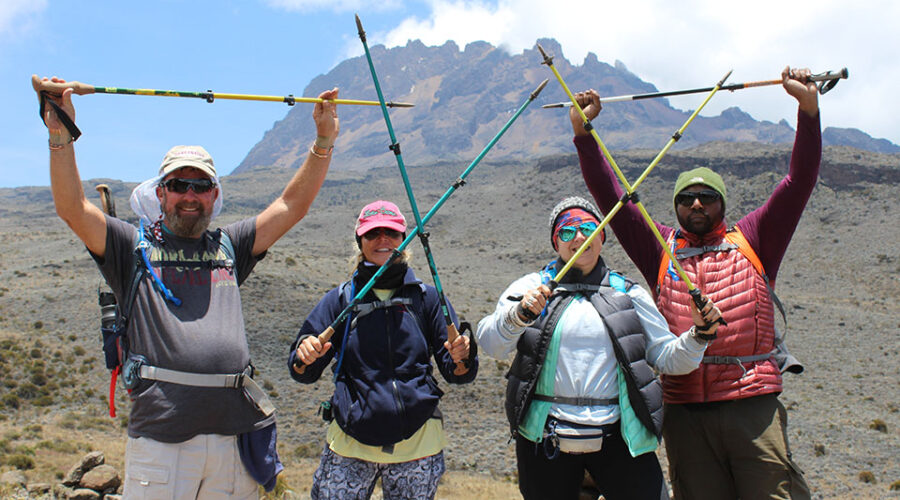The Kilimanjaro trekking Marangu route 6-day itinerary is what we recommend as it allows one day of acclimatization at Horombo on the 3rd day. Named the Coca-Cola route & considered to be the easiest route of all, this has proved wrong as we have encountered a high failure rate on this route. This is due to that perception which leads to poor preparation and untimely attempts. Despite being fairly easy the final part of the summit is hard. Marangu is the only route that offers hut accommodation with beds & mattresses. Soft drinks, mineral water, chocolate bars & beer can be purchased at the camps but trash-in trash-out is closely observed.
Marangu route 6 days itinerary is advisable though you can still hike for 5 days and miss the acclimatization day at Horombo which may sometimes be the reason for not making it to the top. Short Tanzania safari or beach holidays to Zanzibar can be combined with your Kilimanjaro hiking upon request.
Arrive in Tanzania via Kilimanjaro International airport (JRO), Ron Adventure’s staff will pick you up and transfer you to Moshi or Arusha town where you will spend the first night at a hotel. Those who will arrive through Jomo Kenyatta International Airport (JKIA) in Kenya, we will pick you up and get you transferred by Shuttle bus to Moshi/Arusha.
A morning pre-climb briefing and introductions with our team precede the drive to Kilimanjaro Park’s Eastern Gate: Marangu, which lies at 1,860 m. Here, your head guide arranges all necessary permits and registration for rescue and search services before you start the walk to Mandara Hut’s 2,700 m. The trail takes you through the rain-forest with its high probability of rain showers, so bring a raincoat.
This being your first day at high altitude we strongly recommend the following:
Acclimatization-associated discomfort is common at night when your body gets less oxygen than during the day. This is normally expressed in the form of nausea and headaches.
Change in Elevation: Marangu Gate (1,860 M) – Mandara Hut (2,700 M)
Hiking Distance: Approximately 11 Km
Hiking Time: 5-7 Hours
Habitat: Rain-forest
Early in the morning after breakfast, the group will depart Mandara Hut to start a moderate trek towards the second high-altitude camp: Horombo Hut (3,720 m). When you reach the camp on this day, you will be treated to views of two volcanos at once: Kibo and Mawenzi.
Several hours after lunch you will have to complete an acclimatization hike in the direction of Kibo Hut with a 200-meter gain in altitude, and then hike back down to Horombo Hut where dinner will be prepared for you.
Change in Elevation: Mandara Hut (2,700 M) – Horombo Hut (3,720 M)
Hiking Distance: Approximately 10 Km
Hiking Time: 5-6 Hours
Habitat: Grassland
After breakfast you will go on an acclimatization hike towards Kibo Hut and back. After lunch you have the opportunity to walk around the surrounding area, take pictures of Mawenzi Volcano or just sleep before the upcoming trekking to Kibo Hut.
Acclimatization Hike:
Change in Elevation: Horombo Hut (3,720 M) — Destination point en route to Kibo Hut (4,500 M)
Hiking distance: Approximately 5–8 Km
Hiking time: 3–4 hours
On this day, right after breakfast the group will be trekking to the Kibo Hut (4,700 m). The actual trekking is not very difficult, just remember to stick with an appropriate pace to keep up your strength for the trekking to Kilimanjaro’s summit. When you reach the camp you will be served lunch, after which we recommend you sleep as much as you can, avoid any strenuous activity, and drink lots of water.
Change in Elevation: Horombo Hut (3,720 M) – Kibo Hut (4,700 M)
Hiking Distance: Approximately 10 Km
Hiking Time: 4-8 Hours
Habitat: Alpine Desert
Night departure from Kibo Hut (4,700 m) and the start of your trekking to Kilimanjaro’s summit: Uhuru peak (5,895 m). The trekking will be moderate from a physical standpoint, but the altitude presents a much more serious problem. For the entire length of the trekking each pair of climbers will be accompanied by their own guide, who will be monitoring your stamina and mental resolve. After your successful ascent to Uhuru Peak, you can descend to the nearest glacier if desired. Then you will return to Kibo Camp and after a two-hour rest continue your descent to Horombo Hut (3,720 m).
Change in Elevation: Kibo Hut (4,700 M) – Uhuru Peak (5,895 M) – Horombo Hut (3,720 M)
Hiking Distance: Approximately 16 Km
Hiking Time: 9-12 Hours
Habitat: Arctic
You will be offered a warm breakfast in the morning, after which we will head for the Kilimanjaro National Park’s exit: Marangu Gate (1,860 m). After your descent the whole group will gather to congratulate you, and then you will have the chance to share your opinions on the trip in the guestbook. Lastly, we will present you with your commemorative certificates (in our office) and provide you a transfer back to the hotel.
Change in Elevation: Horombo Hut (3,720 M) to Marangu Gate (1,860 M)
Hiking Distance: Approximately 18 Km
Hiking Time: 5-6 Hours
Habitat: Rain-forest
| Number of Travelers | Cost Per Traveler in US($) |
|---|---|
| 1 Person | $1,850 |
| 2 People | $1,830 |
| 3 People | $1,810 |
| 4 People | $1,790 |
| 5 People | $1,770 |
| 6 People | $1,760 |
| 7 People | $1,750 |
| 8 People | $1,740 |
| 9 People | $1,720 |
| Above 10 People | $1,700 |

Mount Kilimanjaro can be climbed anytime throughout the year. Most travelers prefer climbing during the dry seasons: December to March, June to October. Many consider the best months to climb Kilimanjaro to be January, February, and September.
Your Kilimanjaro dream climb is entirely your own to design. We will work with you to customize exactly the triumphant Tanzanian mountainous quest experience you want. You go with the people you choose. You leave on whatever day you wish. You decide on your preferred route option, pace, and the number of days you will take.
You will need a Single entry visa to enter Tanzania. It costs 100$ for US citizens and 50$ for other nationalities. There are 3 ways to apply it.
1. Apply it online from this link – Official link to apply your visa
2. Get a visa on arrival if you are eligible – Read Eligibility Guidelines
3. Apply through Tanzanian Embassy in your home Country
Climbers are strongly advised to obtain travel insurance immediately after booking their trip.
On most routes, you’ll trek 4-7 hours most days. On certain routes you’ll trek as many as 10-15 hours on the longest days.
We are. We are not agents for anybody, but run the treks ourselves through our own registered Tanzanian local company.
The maximum number of people on the trek is eight. Occasionally this may stretch to nine or ten if, for example, there are already 6 people booked on the trek and a group of four want to join. On the rare occasion where this happens we will contact those already booked on the trek to see if they have any objection to the group size to grow above eight.
We can book a trek for just one person but, as stated above, this will be quite expensive. If you are a solo traveler, therefore, we strongly advise you to join one of the scheduled treks.
As we are charged in US dollars, so all our prices are quoted in US dollars too. However, we are able to accept a wide range of other currencies too including sterling, euros, Canadian dollars, Australian dollars, Israeli shekels, Singapore dollars, Indian rupees etc etc
We advise you to spend at least one full day in Tanzania before beginning your trek. Arriving by plane one day and then climbing the next is not the best way to begin a trek.
The guides have been trained in high-altitude medical care. Each trek will also be equipped with a comprehensive first-aid medical kit. The guides also carry oxygen for those people who are suffering from altitude sickness – though this is very much a last resort and the guides are trained to spot altitude sickness before it becomes necessary to use oxygen.
The guides have been trained in high-altitude medical care. Each trek will also be equipped with a comprehensive first-aid medical kit. The guides also carry oxygen for those people who are suffering from altitude sickness – though this is very much a last resort and the guides are trained to spot altitude sickness before it becomes necessary to use oxygen.
Yes, all Tanzania National Park (TANAPA) fees are included in our Kilimanjaro price. Currently, the conservation fees at Kilimanjaro National Park are: US$70 per person per day and US$50 per person per night for camping. Crew entry fees and Tanzanian Forest Services Agency (TFS) fees (applicable for Rongai, Shira and Lemosho routes) are also included in our Kilimanjaro price.
The minimum age limit set by Kilimanjaro National Park for children trekking to Uhuru Peak on Mount Kilimanjaro is 10 years old.
You will have one lead guide and an assistant guide for 2-3 climbers.
For 4-6 climbers, you will have one lead guide and 2 assistant guides.
For 7-8 climbers, you will have one lead guide and 3 assistant guides.
For 9-10 climbers, you will have one lead guide and 4 assistant guides.
We never rush our trek, instead, we like to take in the views and enjoy the experience. Some trekkers may be slower than others, but with our client-to-guide ratio, we are able to support everyone along the way. Our mantra, “pole pole” (Swahili for “slowly slowly”), reminds us to take our time and ensure that all of our trekkers have the opportunity to enjoy the experience fully.
We can offer a discount for more than 2 people, please enquire at the time of booking.
Highly-trained chefs prepare three hot nutritious meals daily, as well as trail snacks and afternoon tea each day. You’ll eat all your meals in a solar-lit dining tent with your fellow trekkers and head guide. Delicious vegetarian, vegan, gluten-free and other specialty meals can be provided (with advance request). We’re happy to send you a sample menu—just ask!
Your mountain camps are set up and broken down each day by expert camp porters. You’ll stay in double occupancy all-weather tents with full-ground pads to keep you and your gear dry. Private toilet tents, solar-lit dining tents with tables and chairs, and basins of hot water for washing are provided in every camp. Grand Traverse treks include upgraded solar-lit walk-in-height sleeping tents with mountaineering beds and mattresses for additional comfort.
The treks vary from six to eight days. The exact length of each trek is written on the Trekking dates and prices page. You can, of course, ask for treks that are longer than eight days and we can arrange this for you – though we don’t book treks for less than 6 days as we feel this is too short to allow you to acclimatize properly.
Always remember to maintain a slow, steady pace from beginning to end. Going slowly allows the body to acclimatize while hiking. Those who start out too quickly will have troubles higher up the mountain as the body will be overexerted. This still holds true if you are spending an extra day on the mountain.
It will depend on the route you pick and your pace. It can take from 4-8 hours to reach the summit from the high camp.
A 15% deposit is required at time of booking to hold your Kilimanjaro climb and 30% for your Tanzania safari.
Do not hesitage to give us a call. We are an expert team and we are happy to talk to you.
+255 749 516 344
info@ronadventure.com
Protected by Security by CleanTalk

